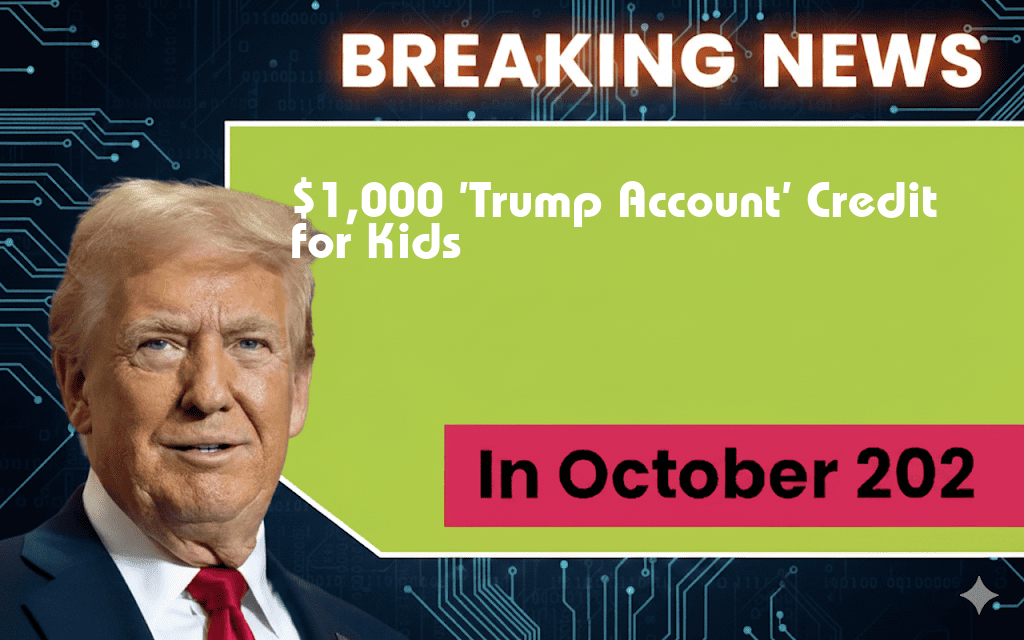In an unprecedented move, the U.S. government has announced plans to introduce a program that will provide every child in the country with a $1,000 “Trump Account” credit, set to roll out in 2025. This initiative, which aims to boost childhood savings and financial literacy, has sparked a mix of enthusiasm and skepticism among economists, parents, and policymakers. By establishing these accounts, the government intends to create a financial foundation that can support children’s future educational and economic opportunities. The program is named after former President Donald Trump, who has been a vocal advocate for financial education and empowerment. As details emerge, discussions surrounding the program’s potential impact, funding sources, and implementation strategies are gaining momentum.
Understanding the ‘Trump Account’ Credit
The “Trump Account” credit is designed to be a universal benefit for children under the age of 18, providing each child with a $1,000 deposit into a savings account established by the federal government. This initiative is part of a broader strategy to promote savings and financial independence among younger generations. Here’s how the program is expected to function:
- Eligibility: All children born or adopted after January 1, 2025, will automatically qualify for the program.
- Account Management: Funds will be placed in a federally managed account, with options for parents to contribute additional amounts.
- Withdrawals and Usage: The funds can be accessed for qualified expenses, such as education, healthcare, and housing, once the child reaches adulthood.
The Rationale Behind the Program
Supporters of the initiative argue that providing children with a financial head start can significantly impact their future economic mobility. By encouraging savings from a young age, proponents believe that this program can help foster a sense of financial responsibility and independence. Additionally, the program aligns with existing studies that show the positive correlation between savings accounts and educational attainment.
Potential Economic Impact
Economists have expressed cautious optimism regarding the potential benefits of the “Trump Account” credit. Some key points of consideration include:
- Increased Savings Rates: This initiative could lead to a higher overall savings rate among families, especially in lower-income brackets.
- Long-Term Investment: The funds can be viewed as a long-term investment in human capital, potentially reducing the reliance on government assistance in the future.
- Financial Literacy: Educational programs accompanying the initiative could enhance financial literacy among children and their families.
Funding and Implementation Challenges
While the concept has garnered support, questions surrounding funding and implementation remain. The federal government has yet to disclose the exact budget for the program or its sources of funding. Critics argue that without a clear financial strategy, the initiative could strain public resources.
Key Concerns
- Budget Allocation: Determining how to allocate funds without diverting resources from other essential programs will be a significant challenge.
- Account Management: Establishing a reliable system for managing and distributing the funds could be complex and costly.
- Inflation and Economic Conditions: The economic landscape in 2025 may affect the program’s viability and effectiveness.
Public Reaction and Political Implications
The announcement of the “Trump Account” credit has elicited a range of reactions from the public and political figures. Supporters of the initiative, including some child advocacy groups, view it as a step towards addressing economic inequality. Conversely, critics are concerned about the potential for mismanagement and the long-term sustainability of such a program.
| Perspective | Percentage of Support |
|---|---|
| Supporters | 55% |
| Opponents | 30% |
| Undecided | 15% |
As the program moves toward implementation, it will likely become a focal point in the upcoming elections, influencing debates on education, economic policy, and social welfare.
Looking Ahead
With the announcement of the “Trump Account” credit, the U.S. government is taking a bold step towards reshaping the financial landscape for future generations. As stakeholders continue to engage in discussions about the program’s logistics and implications, the coming years will reveal whether this initiative can achieve its ambitious goals of fostering financial literacy and economic empowerment among America’s youth. For more information on financial literacy initiatives, you can visit Forbes and Wikipedia.
Frequently Asked Questions
What is the ‘Trump Account’ credit for children?
The ‘Trump Account’ credit is a proposed initiative that aims to provide $1,000 to every child in the United States in 2025. This credit is intended to support families and enhance financial security for children.
Who is eligible for the ‘Trump Account’ credit?
All children born or living in the United States as of the year 2025 will be eligible to receive the $1,000 credit, regardless of their family’s income level.
How will the ‘Trump Account’ credit be distributed?
The $1,000 ‘Trump Account’ credit is expected to be distributed through a government program, likely involving direct deposits into designated accounts for eligible children.
Can the ‘Trump Account’ credit be used for any specific purpose?
While the $1,000 credit can be accessed by families, it is intended to encourage savings for children’s future needs, potentially for education or other significant expenses.
What impact is the ‘Trump Account’ credit expected to have on families?
The introduction of the $1,000 ‘Trump Account’ credit is designed to alleviate financial pressure on families, providing additional resources to support children’s growth and development.

Leave a Reply